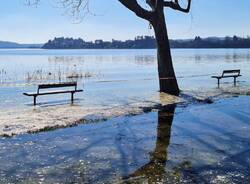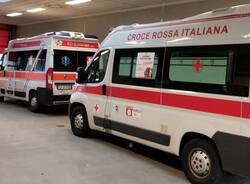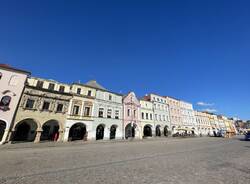From Sesto Calende to Pavia, on foot and by bike
It’s a safe, ninety kilometre route, inside the Ticino Park, along canals and waterways, the blue river and the Via Francisca del Lucomagno. It is surrounded by nature, art and history.
This route, from Sesto Calende to Pavia, is ninety kilometres long and completely safe and accessible, and without any slopes. This walk or ride allows you to discover a unique part of Lombardy, its rivers, dams, historic sites, villas and historical paths. The whole route lies within the Ticino Park, which has now become a MAB area, which also includes Verbano, the Campo dei Fiori Park and the Val Grande Park.
The journey begins on the towpath along the River Ticino, in Sesto Calende, before going along the Canale Villoresi, after the Panperduto Dam, and then the Naviglio Grande in Turbigo, where it heads to Abbiategrasso (the Via Francisca del Lucomagno, which leads to Pavia, intersects in Castelletto di Cuggiono). In Abbiategrasso, you leave the Naviglio Grande, which continues on the left to Milan, and take the Naviglio di Bereguardo to the village of the same name. Along this part of the route stands the Morimondo Abbey.
From Bereguardo, passing along minor and country roads, you come to the city gates, and then to the Covered Bridge in Pavia, along a cycle path.
THE ITINERARY
Sesto Calende – Miorina Dam 3.4 km
Panperduto Dam 10.4 km
Tornavento 22.6 km
Turbigo 31.0 km
Castelletto di Cuggiono 37.6 km
Abbiategrasso 55.0 km
Morimondo 60.0 km
Bereguardo 74.0 km
Pavia 90.0 km
The route can be travelled entirely on foot or by bike, and is accessible also to people with reduced mobility. When on foot, you can make a number of stops. For logistical reasons, linked to sleeping accommodation, you can make your first stop either in Panperduto, where there is a hostel, or in Tornavento. From there, you can make your second stop in Castelletto di Cuggiono, then in Morimondo and eventually in Bereguardo.
You have two alternatives when you decide to use your bike: you may decide to ride the whole route in one day, or to stop in Castelletto di Cuggiono, where you can find a cheep hotel to spend the night.
From Sesto Calende to the Miorina Dam
The first stretch is 3.4 km long. You can leave the centre of Sesto Calende and continue bedside the River Ticino. On this lovely walk, you will discover the relationship between nature and man’s work. Right after the dam, there are beaches and, further up, the archaeological area of Golasecca.
From the Miorina Dam to Panperduto
This stretch runs along the River Ticino and is 7 km long. Along the towpath, you will come to the power station of Porto della Torre and the first bridge that links Lombardy to Piedmont, along State Road 336. “This place will enchant you,” according to the Panperduto website. “Here, water is the main feature, you can feel its magnificence and power; you’ll be amazed by the complexity of its path from the river, how it’s redirected and channelled. Here, human intelligence was able to control the water by building one of the most important hydraulic junctions in Lombardy, where part of the water in the River Ticino is diverted, to create two very important canals: the Canale Villoresi, which is used for irrigation, and the Canale Industriale, which is essential for energy production. The Panperduto Dam, on the River Ticino, and the associated works were inaugurated in 1884, following the project by Eugenio Villoresi, after several years of research and variations.”
From Panperduto to Tornavento
This stretch is 12.2 km long. You leave the towpath on the River Ticino, and begin walking alongside the Canale Villoresi, to arrive directly beneath the former Austro-Hungarian Customs House, today the current headquarters of the Ticino Park. Here, we recommend you make a stop, to discover the beauties of Via Gaggio, where there is a sort of open-air, historical museum and the lookout point in Tornavento, an enchanting village with a breath-taking view over Piedmont and the Alps.
From Tornavento to Turbigo
This stretch is 8.4 km long. You need to be careful and take the towpath along the Canale Villoresi, which leads to Monza. Turbigo boasts an ancient history that dates back to the age of the Roman Empire. You can find many details on the council website. In this territory, you can find the Turbigo thermoelectric power station, which was powered up for the first time in 1928. The power station occupies an area of 56 hectares, on the right bank of the Naviglio Grande.
From Turbigo to Castelletto di Cuggiono
This stretch is 6.6 km long. Leaving the Canale Villoresi, the route continues along the towpath of the Naviglio Grande. This navigable canal was created taking water from the River Ticino near Tornavento, and it ends at the Porta Ticinese Dock, in Milan. It has a total height difference of 34 m, over a distance of 49.9 km. Between Tornavento and Abbiategrasso, it varies in width from 22 to 50 m, and between Abbiategrasso and Milan, it narrows to a width of 15 m, reducing to 12 metres at the end. The flow rate at Turbigo is 64 m³ per second in the summer, and 35 m³ in the winter.
In Castelletto di Cuggiono there is the Via Francisca del Lucomagno, an ancient historic route, which starts in central Europe, in Constance, and continues on to Pavia.
From Castelletto di Cuggiono to Abbiategrasso
This stretch is 17.4 km in length, all along the towpath of the Naviglio Grande. Along the route, you will come across interesting villages. Continue on to Bernate Ticino, where you can admire the Rectory of San Giorgio. One of the jewels of this section of the route is Boffalora Sopra Ticino, a small village that is rich in history, that owes its growth to its closeness to the Naviglio Grande, as does Robecco sul Naviglio, where there are numerous villas. Before arriving in Abbiategrasso, there is Cassinetta di Lugagnano, one of the oldest villages in the Po Valley, where you can admire a statue of Carlo Borromeo, who passed through here shortly before his death.
Some sections of the Naviglio Grande are navigable; for useful information, click here.
From Abbiategrasso to Morimondo
This stretch is 5 km long. In Abbiategrasso, leave the Naviglio Grande, which goes left, to the Milan Dock. Go to the right side of the Naviglio di Bereguardo, and continue for four kilometres before taking a detour of one kilometre to reach a village with a beautiful Cistercian abbey, a place of worship and spirituality, but also an environmental treasure. At the foot of the imposing abbey lies the valley of the Ticino Park, with its many paths, cultivated land and woods.
From Morimondo to Bereguardo
This stretch is 14 km in length, along the towpath of the Naviglio di Bereguardo. Along this stretch, you can enjoy the Lombardy countryside, with its various crops and numerous farmsteads.
Seventh section of the Via Francisca del Lucomagno
From Bereguardo to Pavia
This is 16 km long and can be explored by following the signs and tracks of the Via Francisca del Lucomagno, which lead to the outskirts of Pavia and then along a cycle path beside the River Ticino to the town’s covered bridge.
This is where our journey ends, but if you have the time and energy, it is good to know that Pavia is a crossroads for many other routes, such as the Via Francigena, which leads to Rome, the Via degli Abati, and the Naviglio Pavese, which takes you to Milan.
Pavia is worth a visit to get to know the numerous places in the town, from the castle to the cathedral and the Basilica of San Pietro in Ciel D’oro, where St Augustine is buried.
USEFUL INFORMATION AND LINKS
The Ticino Park was created in 1974 to protect and safeguard the environment of the Lombardy region along the River Ticino. It extends from Lake Maggiore to the point where it meets the River Po, over a total area of approximately 92,000 hectares, in 47 municipalities in the provinces of Varese, Milan and Pavia. Thanks to its heritage of nature, landscapes, art and history, the Ticino Valley was recognised by UNESCO as a Biosphere Reserve, in 2002. It has a dense network of paths, which cover the whole area of the park.
This is an ancient historical path that starts in Constance and reaches Pavia, covering 510 km. It enters Italy at Lavena Ponte Tresa, on Lake Ceresio, and from there, over 135 km, an eight-day walk, arrives in Pavia. It crosses this route in Castelletto di Cuggiono, and from that point on, the two routes coincide. We recommend you visit the Francisca website, for more information, including on accommodation.
HOW TO ARRIVE AND RETURN
The best way to get to Sesto Calende is by train with Trenord. Check this website for timetables and ticket prices. The same thing can be done once you arrive in Pavia. At several places along the route, there are villages where there is a railway line.
Translated by Bosio Fiorelisa and Castagna Alessia
Reviewed by prof. Rolf Cook
La community di VareseNews
Loro ne fanno già parte
Ultimi commenti
Valeria Vernon su MV Agusta la situazione è critica: il sindacato dice no ai licenziamenti collettivi
lenny54 su Carabinieri e polizia locale sventano la maxi rissa del sabato pomeriggio a Luino con 200 persone
Sca su Riapre il bando per la gestione dell'ex Lido di Luino
ccerfo su Finti addetti, gioielli in frigorifero, truffe al peperoncino: i carabinieri spiegano agli anziani di Ferno come reagire
Felice su Carabinieri e polizia locale sventano la maxi rissa del sabato pomeriggio a Luino con 200 persone
Felice su Pomeriggio di botte in piazza Repubblica a Varese: rissa tra una ventina di ragazzi, coinvolti anche minorenni














Accedi o registrati per commentare questo articolo.
L'email è richiesta ma non verrà mostrata ai visitatori. Il contenuto di questo commento esprime il pensiero dell'autore e non rappresenta la linea editoriale di VareseNews.it, che rimane autonoma e indipendente. I messaggi inclusi nei commenti non sono testi giornalistici, ma post inviati dai singoli lettori che possono essere automaticamente pubblicati senza filtro preventivo. I commenti che includano uno o più link a siti esterni verranno rimossi in automatico dal sistema.